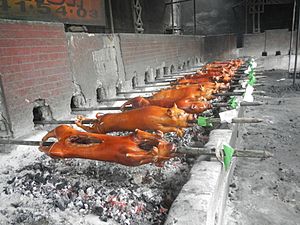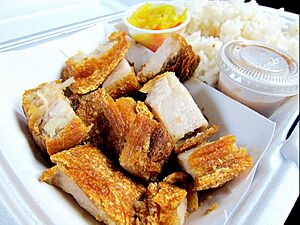Lechon facts for kids

Lechón being roasted in one of the lechón stores in La Loma, Quezon City, Philippines
|
|
| Alternative names | Cochinillo |
|---|---|
| Course | Dish |
| Place of origin | Spain |
| Serving temperature | Hot |
| Main ingredients | Suckling Pig |
| Variations | Stuffing of lemongrass, onion, garlic (for Visayan variant) |
Lechón is a delicious roasted pig dish. It is very popular in Spain and many countries that were once part of the Spanish Empire. The word Lechón comes from Spanish. It means a roasted baby pig, also called a "suckling pig." This is a piglet that still drinks its mother's milk.
Lechón is a favorite food in places like the Philippines, Cuba, Puerto Rico, and the Dominican Republic. It is also loved in other Spanish-speaking countries in Latin America. The dish is made by roasting a whole pig over hot charcoal. Some people even call it a national dish in Cuba, Puerto Rico, and Spain.
In the Philippines and other Austronesian areas, people have been roasting pigs for a very long time. This tradition started even before the Spanish arrived. While it uses the Spanish name, in these places, "lechon" often means a roasted adult pig, not just a baby pig. Many consider it one of the unofficial national dishes of the Philippines. The famous chef Anthony Bourdain even said that Cebu has the best roasted pigs!
Contents
How Lechón is Made Around the World
Lechón is prepared in different ways depending on the country. Each place adds its own special touch to this tasty dish.
Lechón in the Philippines
In the Philippines, lechón (sometimes spelled litson) is a traditional food. People prepare it all year for special events, parties, and holidays. Even though it has a Spanish name, roasting pigs in the Philippines began long ago. Pigs were among the first animals raised by Austronesian cultures. They brought pigs with them as they traveled across the ocean.
The old Filipino name for roasted pig is "inihaw [na baboy]" in Tagalog. This means "charcoal-roasted pig." In Cebu, it was once called inasal. But over time, the Spanish word "lechon" became more common. Now, "lechon" means any roasted pig in the Philippines. If they want to talk about a roasted baby pig, they call it "lechon de leche."
Lechón is a national dish of the Philippines. There are two main ways to make it: the "Manila lechon" (or "Luzon lechon") and the "Cebu lechon" (or "Visayas lechon").
Visayan Lechón Style
Visayan lechon is made by stuffing the pig with many herbs. These often include scallions, bay leaves, black peppercorn, garlic, and salt. A special ingredient is tanglad (lemongrass) or leaves from native Citrus or tamarind trees. Some people in Hiligaynon people areas also stuff the pig with sour fruits like batuan or binukaw (Garcinia binucao). This style is usually cooked over charcoal made from coconut husks. Because it is already full of flavor, it is served with very little dipping sauce. Sometimes just salt and vinegar, or silimansi (soy sauce, calamansi, and labuyo chili).
Luzon Lechón Style
Luzon lechon is usually not stuffed with herbs. If it is, it's often just salt and pepper. What makes Manila lechon special is its liver-based sauce. This sauce is called "lechon sauce." It is made from vinegar, brown sugar, salt, pepper, mashed liver (or liver spread), breadcrumbs, garlic, and onion. Manila lechon is typically cooked over wood fire.
Both types of lechon are rubbed with salt or spices on the skin. This helps make the skin very crispy. Cooks also baste the pig often as it cooks. Sometimes, carbonated drinks are used for basting. The pig is cooked on a bamboo spit over charcoal for several hours. It is turned constantly until it is perfectly done. This cooking process makes the pork skin very crisp, which is a key part of the dish.
What Happens to Leftovers
Leftover parts of the lechon, like the head and feet, are often used to make another popular dish called lechon paksiw. Just like lechon, lechon paksiw can be made Luzon-style or Visayas-style. The Luzon version uses liver sauce, while the Visayas version does not. Sometimes, old lechon can also be made into other dishes, like Sisig.
Lechón in Puerto Rico
Lechón is considered a national dish in Puerto Rico. There, it is called lechón asado. It is a traditional food served during festivals and holidays.
Lechona in Colombia
Lechona, also known as lechón asado, is a popular dish in Colombia. It is similar to roasted pig dishes in other South American countries. Lechona is a roasted pig stuffed with yellow peas, green onion, yellow rice, and spices. It is cooked in an outdoor brick oven for many hours. This dish is most traditional in the Tolima Department in central Colombia. It is usually served with arepas, which are corn-based breads.
Images for kids




